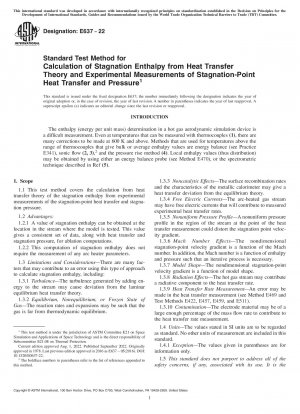ASTM E637-22
Standard Test Method for Calculation of Stagnation Enthalpy from Heat Transfer Theory and Experimental Measurements of Stagnation-Point Heat Transfer and Pressure
- Standard No.
- ASTM E637-22
- Release Date
- 2022
- Published By
- American Society for Testing and Materials (ASTM)
- Latest
- ASTM E637-22
- Scope
- 1.1 This test method covers the calculation from heat transfer theory of the stagnation enthalpy from experimental measurements of the stagnation-point heat transfer and stagnation pressure. 1.2 Advantages: 1.2.1 A value of stagnation enthalpy can be obtained at the location in the stream where the model is tested. This value gives a consistent set of data, along with heat transfer and stagnation pressure, for ablation computations. 1.2.2 This computation of stagnation enthalpy does not require the measurement of any arc heater parameters. 1.3 Limitations and Considerations—There are many factors that may contribute to an error using this type of approach to calculate stagnation enthalpy, including: 1.3.1 Turbulence—The turbulence generated by adding energy to the stream may cause deviation from the laminar equilibrium heat transfer theory. 1.3.2 Equilibrium, Nonequilibrium, or Frozen State of Gas—The reaction rates and expansions may be such that the gas is far from thermodynamic equilibrium. 1.3.3 Noncatalytic Effects—The surface recombination rates and the characteristics of the metallic calorimeter may give a heat transfer deviation from the equilibrium theory. 1.3.4 Free Electric Currents—The arc-heated gas stream may have free electric currents that will contribute to measured experimental heat transfer rates. 1.3.5 Nonuniform Pressure Profile—A nonuniform pressure profile in the region of the stream at the point of the heat transfer measurement could distort the stagnation point velocity gradient. 1.3.6 Mach Number Effects—The nondimensional stagnation-point velocity gradient is a function of the Mach number. In addition, the Mach number is a function of enthalpy and pressure such that an iterative process is necessary. 1.3.7 Model Shape—The nondimensional stagnation-point velocity gradient is a function of model shape. 1.3.8 Radiation Effects—The hot gas stream may contribute a radiative component to the heat transfer rate. 1.3.9 Heat Transfer Rate Measurement—An error may be made in the heat transfer measurement (see Method E469 and Test Methods E422, E457, E459, and E511). 1.3.10 Contamination—The electrode material may be of a large enough percentage of the mass flow rate to contribute to the heat transfer rate measurement. 1.4 Units—The values stated in SI units are to be regarded as standard. No other units of measurement are included in this standard. 1.4.1 Exception—The values given in parentheses are for information only. 1.5 This standard does not purport to address all of the safety concerns, if any, associated with its use. It is the 1 This test method is under the jurisdiction of ASTM Committee E21 on Space Simulation and Applications of Space Technology and is the direct responsibility of Subcommittee E21.08 on Thermal Protection. Current edition approved Aug. 1, 2022. Published September 2022. Originally approved in 1978. Last previous edition approved in 2016 as E637 – 05(2016). DOI: 10.1520/E0637-22. 2 The boldface numbers in parentheses refer to the list of references appended to this method. Copyright © ASTM International, 100 Barr Harbor Drive, PO Box C700, West Conshohocken, PA 19428-2959. United States This international standard was developed in accordance with internationally recognized principles on standardization established in the Decision on Principles for the Development of International Standards, Guides and Recommendations issued by the World Trade Organization Technical Barriers to Trade (TBT) Committee. 1 responsibility of the user of this standard to establish appropriate safety, health, and environmental practices and determine the applicability of regulatory limitations prior to use. 1.6 This international standard was developed in accordance with internationally recognized principles on standardization established in the Decision on Principles for the Development of International Standards, Guides and Recommendations issued by the World Trade Organization Technical Barriers to Trade (TBT) Committee.
ASTM E637-22 Referenced Document
- ASTM E341 Standard Practice for Measuring Plasma Arc Gas Enthalpy by Energy Balance
- ASTM E422 Standard Test Method for Measuring Heat Flux Using a Water-Cooled Calorimeter
- ASTM E457 Standard Test Method for Measuring Heat-Transfer Rate Using a Thermal Capacitance (Slug) Calorimeter
- ASTM E459 Standard Test Method for Measuring Heat Transfer Rate Using a Thin-Skin Calorimeter
- ASTM E511 Standard Test Method for Measuring Heat Flux Using a Copper-Constantan Circular Foil, Heat-Flux Gage
ASTM E637-22 history
- 2022 ASTM E637-22 Standard Test Method for Calculation of Stagnation Enthalpy from Heat Transfer Theory and Experimental Measurements of Stagnation-Point Heat Transfer and Pressure
- 2005 ASTM E637-05(2016) Standard Test Method for Calculation of Stagnation Enthalpy from Heat Transfer Theory and Experimental Measurements of Stagnation-Point Heat Transfer and Pressure
- 2005 ASTM E637-05(2011) Standard Test Method for Calculation of Stagnation Enthalpy from Heat Transfer Theory and Experimental Measurements of Stagnation-Point Heat Transfer and Pressure
- 2005 ASTM E637-05 Standard Test Method for Calculation of Stagnation Enthalpy from Heat Transfer Theory and Experimental Measurements of Stagnation-Point Heat Transfer and Pressure
- 1998 ASTM E637-98 Standard Test Method for Calculation of Stagnation Enthalpy from Heat Transfer Theory and Experimental Measurements of Stagnation-Point Heat Transfer and Pressure
